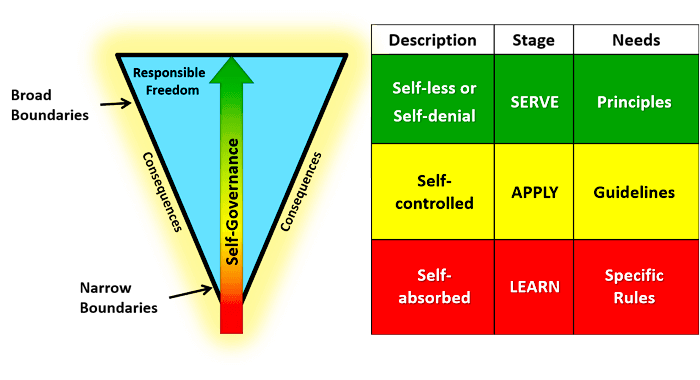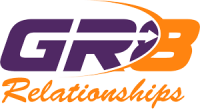Responsible freedom is what people with great values pursue. And there is a direct relationship between responsible freedom and self-governance.
Our Freedom V tool helps explain freedom, self-governance, rules or boundaries, and consequences in one simple graphic. Additionally, it is easy to explain and draw, especially if you do not include the table to the right of the graphic.
The two most essential elements are the 1) V shape and the 2) arrow in the middle of the V.

It is for freedom that Christ has set us free. Stand firm, then, and do not let yourselves be burdened again by a yoke of slavery. – Galatians 5:1
Understanding the Graphic
First, the right and left lines form a V shape representing boundaries or the limits of acceptable behavior. When you create clear boundaries that are easy to understand, you remove confusion about expectations. So, please clearly communicate the boundaries.
Second, the space inside the V is the area of Responsible Freedom. In this area, you operate freely. Notice how freedom increases as you move up the V shape.
It is essential to understand that the V structure appears in destructive and constructive organizations. Even in the most disgusting dictatorships or gangs, some people gain more freedom by following the rules - however perverse they are. Any member of the gang that stays within the "responsible freedom" range is likely obeying the gang's rules.
Third, outside the V are consequences for crossing the boundaries. Once you cross the boundary, you move into the area of Irresponsible Freedom. Again, this applies to both good and bad value organizations. It is best to state the consequences when you discuss and set boundaries.
Finally, the arrow in the middle represents self-governance. The color on the arrow portrays the degree of self-governance. At the bottom, there is minimal self-governance. The yellow and green represent the increase in self-governance as you move from bottom to top. Finally, the colors directly correlate with the narrow or expanded responsible freedom.
Levels of the Freedom V
So, when you abide by the rules of the structure and stay inside the boundaries, greater responsible freedom is available. In other words, the more you demonstrate self-governance, the more responsible freedom is available.
In the graph above, the table to the right provides additional ways to look at the Freedom V. We see self-governance in 3 distinct levels that overlap.
Again, the Freedom V works with any structure and is especially good for families and organizations.
Application
A person with self-governance considers others and how their actions impact others. They stay within the V as long as the freedom inside is about good and Godly values.
Suppose you are responsible for a baby and, as a wise parent, desire to act as God does with you. You create tight boundaries for them because they do not have knowledge or experience with the way things work in the world. You put them in controlled environments like a crib or playpen, watch and help them reduce significant harm to themselves. At the same time, you provide them enough freedom to see if they can learn how to stay within the boundaries.
You still have relatively tight boundaries when the baby grows into a toddler. They are learning how to stay within the boundaries for the freedom that you allow. And they experience the consequences when they don’t. The rules and expectations you provide them are an invitation to live wisely. They are about making sure they know you are the one in charge. You invite them to live by rules because it helps them escape the consequences. If you see them approaching a boundary, you may warn them but allow them to choose if the consequences aren’t too severe.
When a child grows older, you expand the boundaries as they show the ability to make the right choices. Since you have taught them how to recognize boundaries for themselves, they hopefully make good choices while away from you at school, with friends, or by themselves. The more they show self-governance, the more they operate within responsible freedom. You reduce freedom when they cross a boundary by moving them down the V.
You might say to an older child, “go where you want, be safe and be home by nightfall.” If that does not happen, and it was determined to be willful disobedience, you move them down the freedom V until they demonstrate they will come home at the designated time.
The end goal is a child who sets their own boundaries inside the clear boundaries God set for us.
Self-governance
If you remember, the definition of self-governance is “delaying immediate gratification for future benefit.” Another simple, practical way to see self-governance is by setting boundaries for yourself rather than the authorities. Of course, those boundaries are within the overall boundaries set by God and His designated authority channels (Romans 13).
You love and value people when you commit to influencing people to be self-governing. You cannot do it for them. As much as you might want to control, it is often best to allow people to cross the boundary and suffer the consequences, if not too severe for them or the organization. You can control the people you lead, but it is seldom the best action. Exercising personal freedom is an essential part of what it means to be human and learning how to be self-governing after experiencing consequences.
If you learn to pre-decide, you become more self-governing and suffer fewer consequences.
So, let’s revisit how freedom works best. First, we have been set free to live a life of freedom, not bondage and obligation.
Galatians 5:1 (ESV) – It is for freedom that Christ has set us free. Stand firm, then, and do not let yourselves be burdened again by a yoke of slavery.
Remember the definition of freedom? “Acting without controlling or being controlled.” Can you misuse freedom and be irresponsible with your freedom? Absolutely! Of course, if you decide to use your freedom to do anything you want, most likely, your freedom will become limited. Why? Because authorities have the freedom to move you down the Freedom V with monetary consequences like fines or physical consequences like jail. God’s wrath is exhibited through authority channels (Romans 13).
So, it is better to be self-governing and put your freedom underneath the higher value of LOVE. When you do that, you limit your freedoms by pursuing the best for others.
Galatians 5:13 (ESV) – For you were called to freedom, brothers. Only do not use your freedom as an opportunity for the flesh, but through love serve one another.
PURSUING THEIR BEST - Freedom in Relationships
Videos you may like
Podcasts you may like

